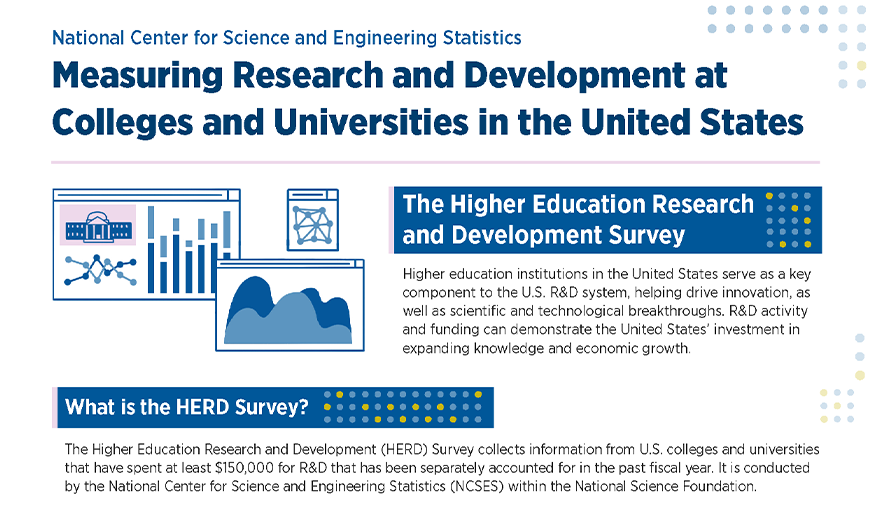Data collection. The FY 2022 questionnaires were sent by e-mail in November 2022. Respondents could choose to submit a questionnaire downloaded from the Web or use the Web-based data collection system. Every effort was made to maintain close contact with respondents to preserve both the consistency and continuity of the resulting data. Survey data reports for each institution were available on the survey website; these showed comparisons between the current and 2 prior years of data and noted any substantive disparities. Questionnaires were carefully examined for completeness upon receipt. Respondents were sent personalized e-mail messages asking them to provide any necessary revisions before the final processing and tabulation of data. These e-mail messages included a link to the HERD Survey Web-based data collection system, allowing respondents to view and correct their data online.
Respondents were asked to explain significant differences between current-year reporting and established patterns of reporting verified for prior years. They were encouraged to correct prior-year data, if necessary. When respondents updated or amended figures from past years, NCSES made corresponding changes to trend data in the 2022 data tables and to the underlying microdata. For accurate historical data, use only the most recently released data tables.
Mode. Respondents could choose to submit a questionnaire downloaded from the Web or use the Web-based questionnaire. All institutions submitted data using the Web-based questionnaire.
Response rates. By the survey’s closing date in July 2023, forms had been received from 864 universities and colleges out of a population of 900—a response rate of 96.0%. Responses were received from 98.4% of all doctorate-granting institutions. The R&D expenditures reported by these doctoral institutions constituted 99.1% of the estimated national R&D expenditures for FY 2022. Table A-4 displays a detailed breakdown of response rates by survey form and highest degree granted, and table A-5 displays a breakdown of response rates for each survey question.
Data editing. The HERD Survey was subject to very little editing. Respondents were contacted and asked to resolve possible self-reporting issues themselves. Questionnaires were carefully examined by survey staff upon receipt. Reviews focused on unexplained missing data, expenditures that were outliers compared to those of peer institutions, and explanations provided for changes in reporting patterns. If additional explanations or data revisions were needed, respondents were sent personalized e-mail messages asking them to provide any necessary revisions before the final processing and tabulation of data.
Imputation. Missing values were imputed based on the previous year’s data and the reported data of peer institutions in the current cycle. For the 34 institutions that had not responded by the closing date of the survey and had been included in the FY 2021 HERD Survey population, R&D expenditures were imputed by applying inflator and deflator factors to the prior year’s key totals. The key totals for FY 2022 included total R&D expenditures, federal R&D expenditures, expenditures received as a subrecipient from higher education sources, expenditures received as a subrecipient from non-higher education sources, expenditures passed through to higher education entities, and expenditures passed through to non-higher education entities. Imputation factors were ratios derived from the 2-year-trend data of responding institutions with similar characteristics, including highest degree granted, type of institutional control (public or private), and level of total R&D expenditures. Other values that were not identified as key totals were imputed by applying ratios from the previous year’s data.
For two institutions that were new to the survey population, no past-year data were available. For these institutions, total R&D expenditures were assumed to be $150,000 or $1,000,000 based on the institutions’ responses to the population review screener. Other values were then imputed as a proportion of total R&D expenditures based on the data of institutions with similar characteristics. Data for partial nonresponse were imputed using similar techniques.
Table A-6 through table A-18 present imputed amounts for each applicable survey variable. The dollar amount imputed is displayed, along with the percentage it represents of the national estimate for universities and colleges for a variable. The imputed total R&D was $87.5 million, or 0.1%, of the $97.8 billion in total R&D expenditures (table A-6).
Several surveyed institutions have responded intermittently in past years. For years in which no response was received, data have been imputed as previously described. Although the imputation algorithm accurately reflects national trends, it cannot account for specific trends at individual institutions. For this reason, a re-imputation of institutional data for prior years is also performed. For each institution, previously imputed values from the HERD Survey (FYs 2010–21) were recomputed to ensure that the imputed data are consistent with reporting patterns from the FY 2022 survey. These procedures result in much more consistent reporting trends for individual institutions but have little effect on aggregate figures reflecting national totals. In the data tables, the letter i is used to identify imputed data.
R&D expenditures from unspecified federal agencies (Question 10) and capitalization thresholds for software and equipment (Question 13) were not imputed. Response summaries for these questions can be found in table A-19 and table A-20.
Weighting. Survey data were not weighted.
Variance estimation. No variance estimation techniques were used.
 An official website of the United States government
An official website of the United States government


